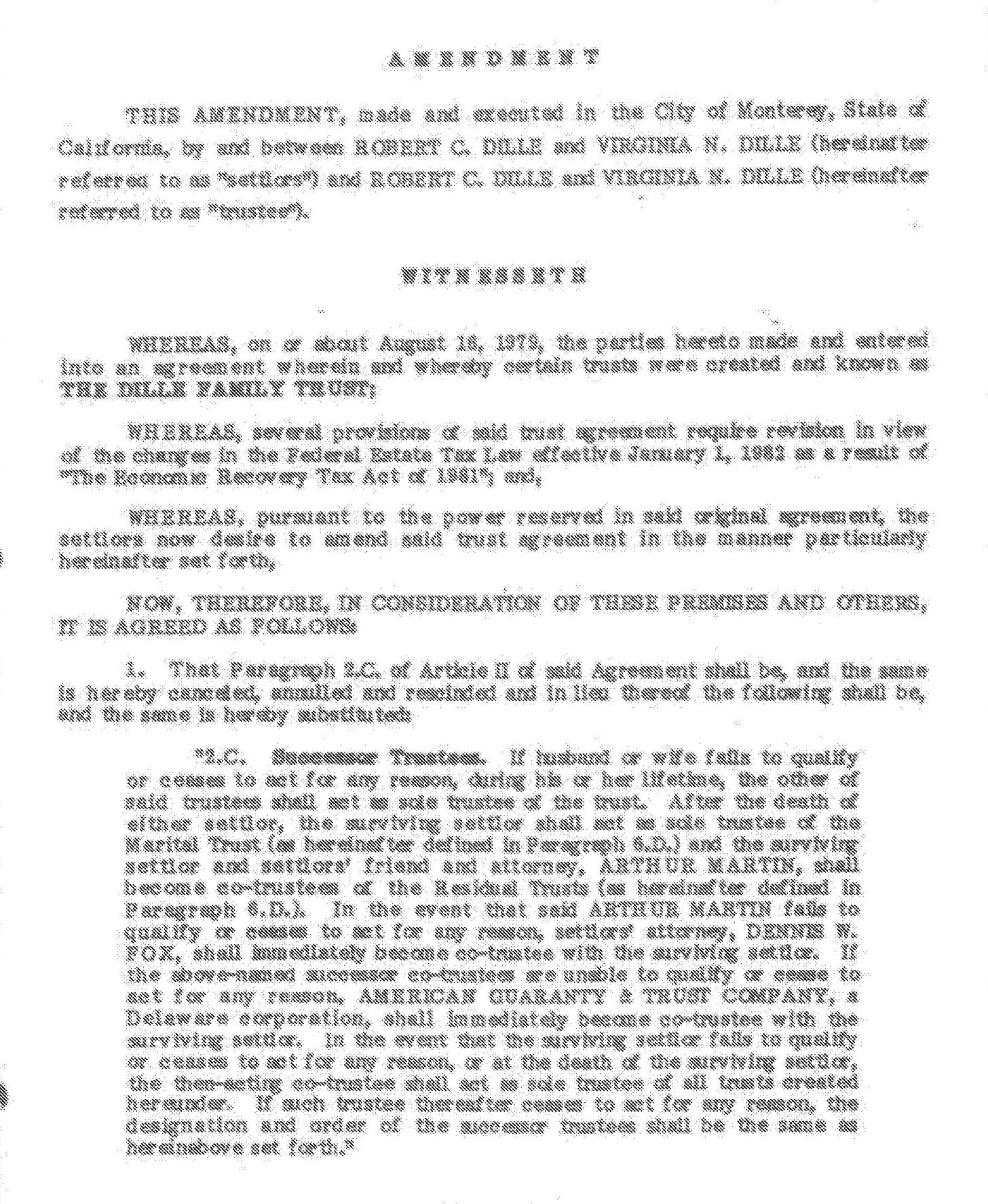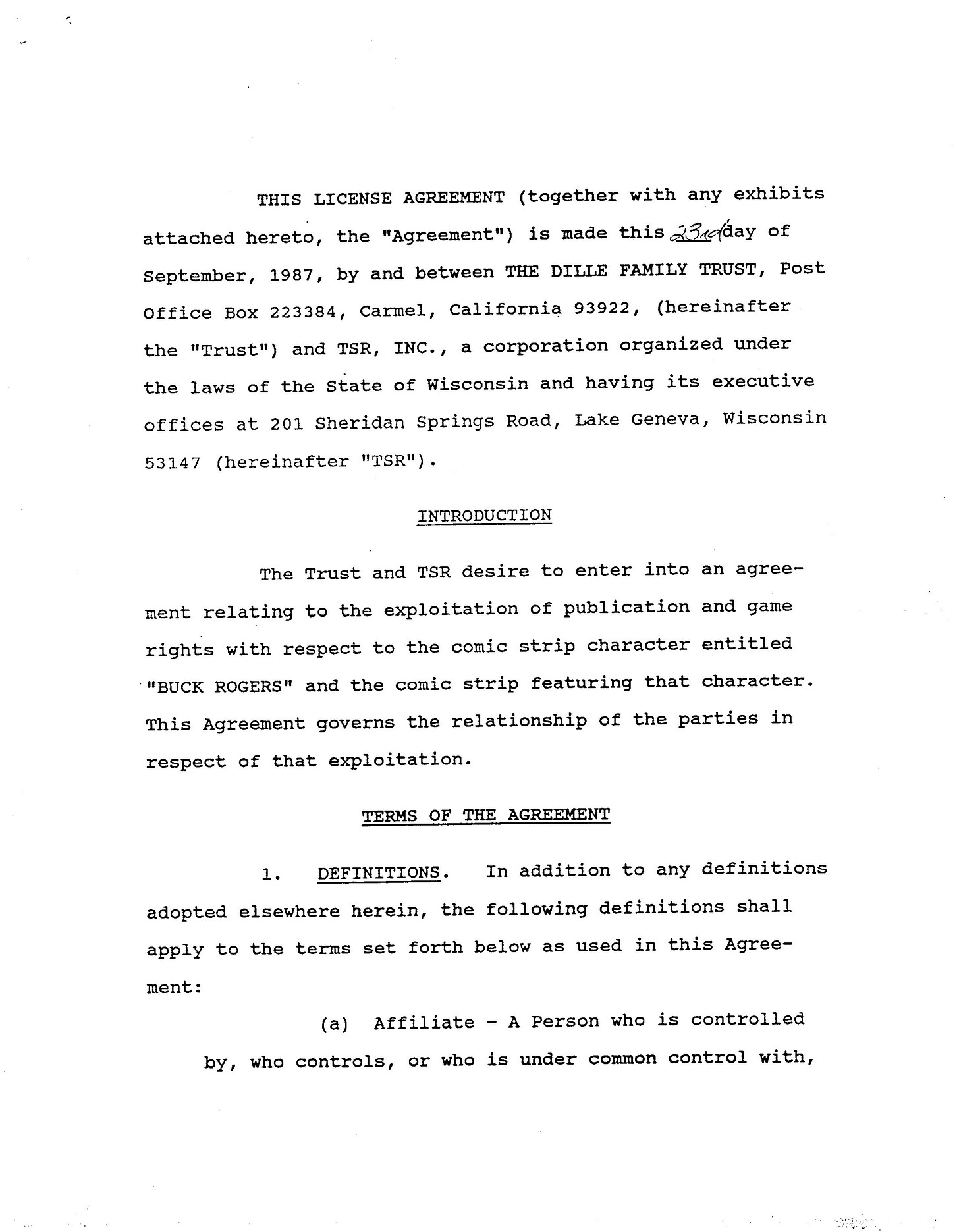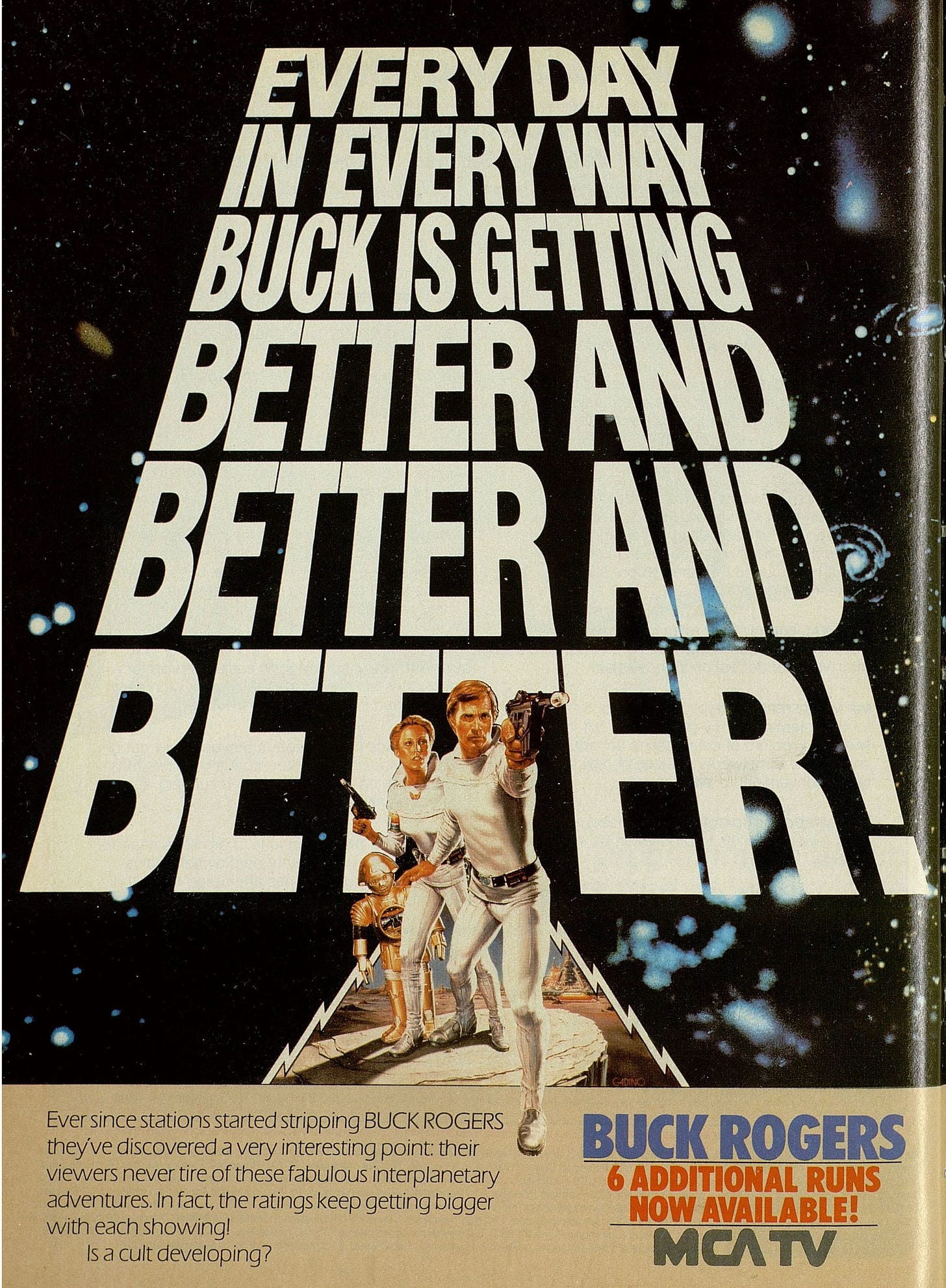Buck Rogers entered the 1980s on a high. A new newspaper strip had been launched in September 1979, and the television show was gaining both good ratings and good reviews. Toys, action figures and games were predominant in the marketplace, all of which added up to more cash coming into the Dille Family Trust than before.
The ownership of the character was still being passed around the Dille family though. On 22 September 1980, Robert C. Dille assigned all copyrights, marks and interests from himself to the Dille Family Trust. Robert C then applied for the trademark renewal for Buck Rogers on 20 November.
Closing off the year, on 9 December 1980, the Buck Rogers (newspaper comics) trademark was formally renewed by Robert C. Dille for the National Newspaper Syndicate, Inc, and Universal City Studios, Inc, registered the copyrights for twenty one episodes of the television show on 19 December.
The television show would be wound up after only seasons, ending on 16 April 1981. It then went into syndication, where it would remain for the rest of the century. In America, Buck Rogers was on television somewhere every week. It was also issued on video (later on DVD) where it remained a solid seller. Before the series ended, the original Buck Rogers, Buster Crabbe, appeared as a guest star.
The movement of rights continued. On 11 September 1981 the Dille Family Trust assigned all copyrights to Robert C. Dille. On 5 January 1982, the Dille Family Trust was amended to include Robert Nichols Flint Dille (aka Flint Dille) as a beneficiary of the Trust. The Trust now had a mechanism for the settlors of the trust (Robert and Virginia Dille) which allowed them to appoint individual or corporate trustees (such as a bank or a financial institution). However the Trust did not provide a mechanism for the beneficiaries to otherwise replace or appoint trustees after the death of their parents. This latter clause would become very important nearly thirty years later when Louise Geer allegedly attempted to take over the Trust.
Now that the Trust was finally sorted out, Robert C. Dille assigns all his trademarks and copyrights to the Trust on 24 September 1982. The rights would now sit with the Trust for the remainder of the twentieth century.
1982 also saw the Trust earn more money by issuing a license to Sega Entertainment.
Our first adventure together was licensing a Buck Rogers game to Sega Entertainment. The game was called Buck Rogers: Planet of Zoom. We made the deal with Sega in November of 1982, somewhere around my twenty-seventh birthday. They paid something like two hundred thousand dollars to slap Buck Rogers on a preexisting game called Zoom 909. I’d seen license slaps before and understood them, and I thought it was great to get Buck Rogers back on the field after the cancellation of the Universal show. – Flint Dille
1983 saw the passing of Robert C. Dille. He died on 31 March, aged 59, in Chicago. His wife, Virginia, was now in control of the Dille Family Trust, but, it would later be explained, in name only. As years went on, Virginia would allow Flint Dille to make the major decisions.
Lorraine Dille Williams was making her own, non-Buck Rogers, moves. She had invested in role playing game publisher TSR, Inc. In 1983, Lorraine was Vice President of the company, and she bought out brothers Brian and Kevin Blume’s shares in the company. In 1985 she outed co-founder Gary Gygax in October 1985, placing her in charge. TSR was collapsing under the weight of debt, and Williams was able to turn this around and make the company profitable. She expanded the company’s focus from board and tabletop games to magazines, books, comic books and collectibles. The company eventually began to fail in 1996, and Williams sold it to Wizards of the Coast in 1997.
In 1984, the Dille Family Trust was granted trademarks for coin operated video games and computer games.
On 1 April 1985, Lorraine Dille Williams took control of TSR. As recounted in the book, Game Wizards.
Williams was about thirty-five at the time, and her educational background was in medieval European history rather than business. Before coming to TSR, she had worked primarily on licensing the intellectual property and trademarks associated with Buck Rogers. She had the “loose change” to invest in TSR because she and her brother came from money: their grandfather John F. Dille published the original Buck Rogers comics, and the Dille family owned the rights to the character and controlled a trust collecting the resulting royalties. The success of the Star Wars franchise had helped propel Buck Rogers back into popular culture: the Buck Rogers in the 25th Century television show, for example, had aired on NBC from 1979 to 1981.
Gygax invited Williams to join TSR as a vice president of administration in an offer letter, dated April 1, which included several stipulations relating to investment. First, Williams’s employment agreement deferred a third of her salary of $90,000 per year into stock purchases, so effectively she would make $60,000—Gygax’s salary as president was now set at $120,000, incidentally. It furthermore required her to immediately purchase $50,000 worth of TSR stock upon accepting the agreement, and to buy a further $100,000 worth of stock in the 1986 calendar year.[1]
On 23 September 1987, the Dille Family Trust entered into a license agreement with TSR, Inc. The agreement, which was signed by Virgina Dille, gave TSR publication and game rights to Buck Rogers. Six days later, TSR filed a trademark application for Buck Rogers boardgames. The first use is stated as 29 July 1988.
1989 marked the sixtieth anniversary of the newspaper strip. Speaking to the media, Flint Dille spoke about plans to bring back the newspaper strip (the second run of the strip had folded in 1983), along with books and new movie.
On 1 February 1989 the Dille Family Trust moved from California to Illinois. The Instrument of Transfer is signed by Virginia, Lorraine and Flint, as beneficiaries, and Arthur Mead Martin (Trustee). On 12 September, the Trust was granted the trademark for board games.
As the 1990s came around, the problem was Buck Rogers was falling back into the almost rans. The television show was long gone, and the lack of comic books was affecting the popularity. The Trust signed a Memorandum of Agreement with Walt Disney Pictures for the development and production of a Buck Rogers film, but the film never saw production.
On 7 October 1994, John F. Dille, Jr, died, aged 80 in Elkhart, Indianapolis. He was the last child of John Flint Dille. He had spent his life largely away from Buck Rogers, instead setting up his own company, Truth Publishing Company, which published newspapers and owned radio stations in Michigan and Oklahoma.
On 2 June 1997, Lorraine Williams sold TSR to Wizards of the Coast. As part of the sale, Williams insisted that her employees be taken care of, but another part of the negotiations would cause some mirth.
One day during the negotiations, Adkison entered the office, and a receptionist greeted him with a pall upon her face. She said, “Ms. Williams needs to talk to you right away.” He thought, Uh-oh, something’s up.
He was ushered into Williams’s office and sat down. There, she gazed at him with an expression full of seriousness and cut right to the chase. “Peter,” she said. “I hope this doesn’t kill the deal. But I cannot include Buck Rogers in the sale.”
Buck Rogers? Buck Rogers? Adkison had no interest in Buck Rogers. Almost nobody did. The company had been putting out Buck material for years, and it always sold abysmally. If Williams’s family hadn’t owned the IP, it is difficult to imagine TSR would have ever sought out such a moldy, age-worn property. Telling him he didn’t have to buy Buck Rogers was like telling him he wouldn’t have to eat a worm. But he didn’t let that show. He kept his business negotiation face on. (“I feel like that was one of my best poker face moments,” he said later.)
He replied to her, “Well, of course that’s going to affect the price.” She nodded.
“And I think we got half a million bucks knocked off the price because Buck Rogers wasn’t part of it,” he said.[2]
As the 20th century ended, the Dille Family were firmly in control of Buck Rogers. It wasn’t like people were lining up to use the character, quite the opposite. The seventieth anniversary of the character came and went with barely a mention. Where he was once futuristic, he was now firmly stuck in the past.
It was the calm before the storm. The battle for Buck Rogers was just about to begin.
Next: The 2000s. Sides are taken. Let the fighting begin!
[1] Peterson, Jon. Game Wizards: The Epic Battle for Dungeons & Dragons
[2] Riggs, Ben. Slaying the Dragon: A Secret History of Dungeons & Dragons









